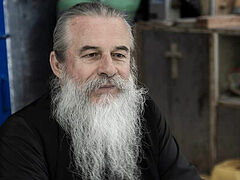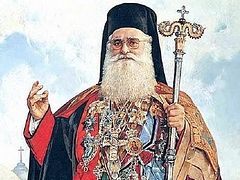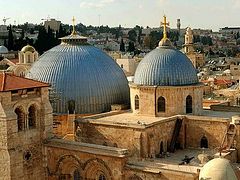Yisca Harani (born 1961) is an historian from Israel. She works at the Yad Ben Zvi Institute and teaches the History of Christianity at the courses for tour guides offered by the Israel Ministry of Tourism. Yiska Harani, among other things, studied the murder case of Archimandrite Philoumenos (Hasapis, †1979) and the investigation that followed.
 Holy Hieromartyr Philoumenos the Hagiotaphite —Yisca, how did you survive all these months, deprived of an opportunity to teach in a traditional setting?
Holy Hieromartyr Philoumenos the Hagiotaphite —Yisca, how did you survive all these months, deprived of an opportunity to teach in a traditional setting?
—It was really good to get a break from the usual rat race and teach online lectures in Zoom. During that time, thousands participated in my online classes—a number impossible to reach in Israel using the classical on-site teaching format. I used to teach a class of 360 students in one of the largest auditoriums in Haifa. But during the western Christmas season this year, there were about a thousand listeners in my Zoom class, mostly young Jewish people, who learned about Christmas. So it turned that, in the end, this format was useful for many people.
—Isn’t it true that you are one of the most popular Jewish academic lecturers?
—Popularity is a dangerous thing. It can be quite cheap. The same applies to professors. When I studied Latin at Tel Aviv University, our class had only four students. You may say the lessons weren’t popular…
—I would rather say it’s not the lessons but that the Latin language wasn’t popular… So, did you graduate from Tel-Aviv University?
—I usually reply that I studied in two universities—in Tel Aviv and Jerusalem. Formally, yes, I did graduate from the university in Tel Aviv. However, I was lucky to study under my father for a long time (Prof. Zwi Werblowsky, Dean at the Faculty of Humanities and founder of the Department of Comparative Religion); he was an extraordinary fountain of knowledge for me. I remain truly grateful to him as he aroused my interest in the history of religions. I never went to my father’s lectures but we held endless conversations over a cup of tea. Then, he would read my essays and simply offer his critique of my writing.
 Yisca Harani, historian —Now, about the murder of Archimandrite Philoumenos (Hasapis) in Nablus on November 29, 1979. You studied the history of this tragic event and the subsequent police investigation. As far as I know, your research is considered a key resource at the Patriarchate of Jerusalem as well.
Yisca Harani, historian —Now, about the murder of Archimandrite Philoumenos (Hasapis) in Nablus on November 29, 1979. You studied the history of this tragic event and the subsequent police investigation. As far as I know, your research is considered a key resource at the Patriarchate of Jerusalem as well.
—During my research, I studied the police archives. I am quite likely the only one who has done it so far. Presently, these archives are stored at a different location and it is possible that, due to the passage of time, these documents have become more accessible. I would like to visit the archives again and take another look at those papers, together with you. It may be so that we can even copy them for publication or research.
Back then, I had to follow their rules: no photography, no copying. But I remembered a few things as I was taking some notes. It helped me gain a general idea of what has happened.
—After Archimandrite Philoumenos was murdered, police apprehended a group of Palestinians, a total of 8 people, who were suspected of being involved in this murder. Who were those people?
—I do not remember that the police papers mentioned anything about them. I am sure there weren’t any names of the detained in those papers. I should say that there was no fear of fundamental Islamism like it exists today. Philoumenos never reported anything of this kind. Of course, there were conflicts with neighbors who were predominantly Muslim. So, I think, the police didn’t arrest anyone but they detained some people who could be the eyewitnesses. They tried to find at least some leads. When witnesses were talking about Jews, the police ignored them: there were no Jews at all around Nablus at the time, just like there were no religious Jewish settlements.
Philoumenos’ murderer was caught and arrested only three years later, in 1982. His name was Asher Raby. His parents were Jews from Afghanistan. Quite likely, he was born there as the Afghani Jews began to arrive in Israel only after 1948. But in 1979, he was already 37. He lived in Jerusalem at first and later moved to southern Tel-Aviv. He worked as a truck driver. He had become deeply religious a few years before committing the crime.
It is important to remember that he had nothing to do with the settlers or any group. As we know from the case papers, Asher Raby was a very lonely person. He was not married and had no children (given that he was 37 in 1979) or friends. Possibly, he studied religion but the lawsuit states that he never traveled in the company of other people and was never seen around other people. He traveled to the hills of Samaria a lot, returning there more than once. During the interrogations, he always spoke singularly about himself. He regularly had visions and heard voices saying things like, “God told ME. God revealed to ME. I saw” etc. He constantly saw and heard things like that.
After his arrest, he was found to be mentally ill and wasn’t placed in jail but admitted to a mental asylum—even after all the crimes he had committed.
 Monastery of Jacob’s Well in Samaria. Photo credit: Pavel Vorobyov/ sobory.ru
Monastery of Jacob’s Well in Samaria. Photo credit: Pavel Vorobyov/ sobory.ru
—Archimandrite Philoumenos’ murder at the end of November 1979 wasn’t the first murder committed by Asher Raby. He murdered him after killing a Jewish doctor in Tel-Aviv in March of the same year, and the family of a “clairvoyant” woman from Lod in April of 1979. Apparently, it was his third crime.
—Yes, there is a connection between all of these crimes. He didn’t kill just any Jewish doctor, but an obstetrician who performed abortions in a clinic located on Rothschild Boulevard in the heart of Tel-Aviv. His name was David Kogan. Asher Ruby hacked him to death with an axe in the exam room at the end of a workday.
The Badra family from Lod was of mixed Jewish and Arabic origin. The husband was a Muslim, and the wife was originally from a Jewish family in Akko. Her father had long ago converted to Islam. This woman was known as a “clairvoyant” who had to do with some kind of fortune-telling and healing. Asher Raby murdered them after being prompted by his “voices” and “visions.” He threw a hand grenade inside their apartment and then fired shots using an automatic weapon. Akhmed Badra and their two daughters were killed, but the wife and three other children were only wounded. The police offered a large sum to anyone who could assist in solving this crime.
It is important to remember that these murders weren’t solved for a few years. But their locations are at a short distance from one another. It is the very center of the country, Lod, Tel-Aviv, and southern Tel-Aviv, where the murderer resided. Police did try to work on these cases, as they were greatly publicized, but they couldn’t find any traces that would have led them to the truck driver from southern Tel-Aviv.
 The monastery of Jacob’s Well in Samaria. Southern side chapel of Holy Hieromartyr Philoumenos. Photo credit: Pavel Vorobyov / sobory.ru
The monastery of Jacob’s Well in Samaria. Southern side chapel of Holy Hieromartyr Philoumenos. Photo credit: Pavel Vorobyov / sobory.ru
—Had Asher Raby visited the monastery of Jacob’s Well before he murdered Philoumenos? How did he end up there?
—Certainly, he was there before. Some people testified to police that they saw how a devout Jew came and yelled at Philoumenos.
—These days, it is not easy to get to Nablus, located in the center of Palestinian Autonomy, driving a car with the Israeli license plates. How easy was it for him then to come there from Tel-Aviv?
—During the 1970s and 1980s, people were free to move around anywhere. There was neither the Wall nor any visible presence of a state border. I recall how in 1978 when I was 17, my mom put all of us, six children in total (our dad was always busy at the university), in a car and drove to Nablus just to take in local sights. We had no fear whatsoever. We still keep the photos from that trip. No one feared anything then. So, yes, there was no problem whatsoever to get to Nablus during that time.
As for Asher Raby, he was a driver. It is possible that he arrived in his truck. Since he often traveled to Samaria, he could take interest in this place, named, “Jacob’s Well.” However, the religious Jews neither went there then, nor do they visit it as a holy site today.
—Isn’t Jacob’s Well revered as a Jewish holy site?
—Throughout the ages, Jacob’s Well has never been one of the places of prayer revered by the devout Jews. It is important, because we’ve got the sites held sacred in the Christian tradition. Then, some places were considered holy according to Jewish tradition. Some are considered holy in either culture, others, not. We won’t find Jacob’s Well mentioned as one of the places held sacred by Jews in any historical period, be it during the Byzantine era, the Middle Ages, or today. Therefore, the existence of this place is simply irrelevant to any group, be it the religious settlers or any other Jewish religious group. So, there is no question that Jews could come here and claim this place back.
—What do we know about the murder based on police records?
—When Asher Raby arrived there on November 29, 1979, he went down to a small chapel located beside the well where Fr. Philoumenos conducted a service (a large church wasn’t finished at the time). The first thing he did was to throw a hand grenade inside this small space (he did the same in an attack on a family in Lod a few months earlier). It nearly destroyed that small church. There are traces of explosion still seen on the walls today. It is possible that Fr. Philoumenos was injured. He was not killed as he went up the stairs. That’s when the murderer hit him with the axe. Apparently, Fr. Philoumenos raised hands to protect his head and his pinkie was axed. The blow got him in his head….
 —Can we say that Fr. Philoumenos was aware of any imminent danger from this man?
—Can we say that Fr. Philoumenos was aware of any imminent danger from this man?
—Police reports state that a devout Jew, likely a future murderer, was seen at Jacob’s Well before and had an argument with Philoumenos, who told some people about it. That’s all we know. Did it actually mean he feared for his life? Probably, the future killer threatened him. The problem, the danger, most likely did exist.
—How was Raby finally caught?
—He was apprehended right there at Jacob’s Well on November 17, 1982, when he was climbing over the monastery fence. He came there again intending to commit the murder, using the same axe, of an elderly nun who lived there after Philoumenos was killed. He did manage to wound her. This time, though, there were people around as it took place during the day, so he was caught and handed over to the police. While in custody, he admitted to all the crimes he had committed, describing them at length.
It is important for me that, at some point, Jewish religious radicalism began to spread. When did it start, what were the reasons behind it? We often see that the Islamic terrorists are loners and they are not part of any terrorist organizations, acting on their own. Yet, they absorbed the spirit of religious radicalism that was prevalent in the social environment around them. A mentally deranged person can also take it in. He can go and put words into action even faster than a healthy person who would take time to think it over.
 Asher Raby —Is it official information that Asher Raby was a mentally deranged person?
Asher Raby —Is it official information that Asher Raby was a mentally deranged person?
—Yes. It was in the police reports. The investigation in 1982 wasn’t specifically dedicated to Philoumenos’ murder but also to all other murders he had committed. He was diagnosed with mental impairment and, based on this statement, he was declared unfit to stand trial. As a result, he was admitted to a psychiatric hospital. I reiterate that it was his sentence not only for the murder of a priest but the killings of a Jewish doctor in Tel-Aviv and a family in Lod. Ever since, from the beginning of 1983, we don’t know anything about the fate of this man.
About ten years ago, when I was studying this case, I went with my husband to this man’s place located in the Shapiro area of southern Tel-Aviv. The yard was screened off with the plastic fabric used as fencing material. It was impossible to see anything through it. It gave me the impression of an extremely lonely, secretive, and quite possibly uninhabited place. Unfortunately, I couldn’t find out whether or not he was still alive. Or, whether he is still locked in a mental asylum…
Sadly, it is impossible to find out as, according to Israeli laws, anything relating to psychiatric diagnoses or the history of keeping someone in mental asylums is not subject to disclosure. It is medical privacy. Individuals who committed murder due to mental illness can be “healed” as time goes by, released, and reside next to our children, and we have no right to learn they have such a sinister past… I think it is horrible. I know the Chief Physician at the Israel Prison Service who says that he has no right to speak about what has happened to former mental patients who went through the prison system.
—Is there a photo of Asher Raby? What did he look like? Was he wearing a brimmed hat as he is depicted in some icons?
—I don’t remember seeing any photos in the police file. It was the end of the 1970s, and everything was quite primitive back then. But there was a photo in one of the newspapers. Of course, there was neither a black brimmed hat nor lapserdak but short forelocks and a plaid cap. At the time, the black hat was an attribute of a far more limited number of Jewish congregations than it is today. They were few and far between and they were the ones who never traveled anywhere.
Asher Raby was a religious Jew, but he wasn’t a member of those reasonably isolated “Haredi” groups, just as he wasn’t a religious settler. He was a mentally impaired loner.
 The fact that the murderers are depicted in the clothing they wore doesn’t surprise me. Have you seen the Syrian church in Bethlehem? Right at its entrance, there is an icon of martyrs from the Syrian community of the Ottoman Empire era. Their murderers, the Turks, are depicted in the typical attire they wore at the time. It is the same on the icons of the New Martyrs of Russia, where the murderers are often depicted wearing the Red Army trench coats and “budyonovka” hats topped with red stars. The difference lies in the fact that Christians in the Ottoman Empire were persecuted, and the communists brought persecution against the whole Church. It was an official state policy, even if the murderers weren’t fanatics themselves. On the other hand, the Philoumenos’ murderer didn’t in any way reflect any policy of the state of Israel with regards to the Greek clergy. Even less did he reflect the attitudes of the religious Jewish community to Christianity.
The fact that the murderers are depicted in the clothing they wore doesn’t surprise me. Have you seen the Syrian church in Bethlehem? Right at its entrance, there is an icon of martyrs from the Syrian community of the Ottoman Empire era. Their murderers, the Turks, are depicted in the typical attire they wore at the time. It is the same on the icons of the New Martyrs of Russia, where the murderers are often depicted wearing the Red Army trench coats and “budyonovka” hats topped with red stars. The difference lies in the fact that Christians in the Ottoman Empire were persecuted, and the communists brought persecution against the whole Church. It was an official state policy, even if the murderers weren’t fanatics themselves. On the other hand, the Philoumenos’ murderer didn’t in any way reflect any policy of the state of Israel with regards to the Greek clergy. Even less did he reflect the attitudes of the religious Jewish community to Christianity.
—That’s right. The act of the Patriarchate of Jerusalem concerning the canonization of Archimandrite Philoumenos in 2009 specifies this quite accurately.
—Yes, the Patriarchate of Jerusalem was very specific during the canonization: The words “settlers” or “religious fanatics” weren’t used in the plural form, and they only spoke of an “evil man.”
—Real-life stories often spark legends. But I think that in venerating a martyr, we must tell the truth about him.




